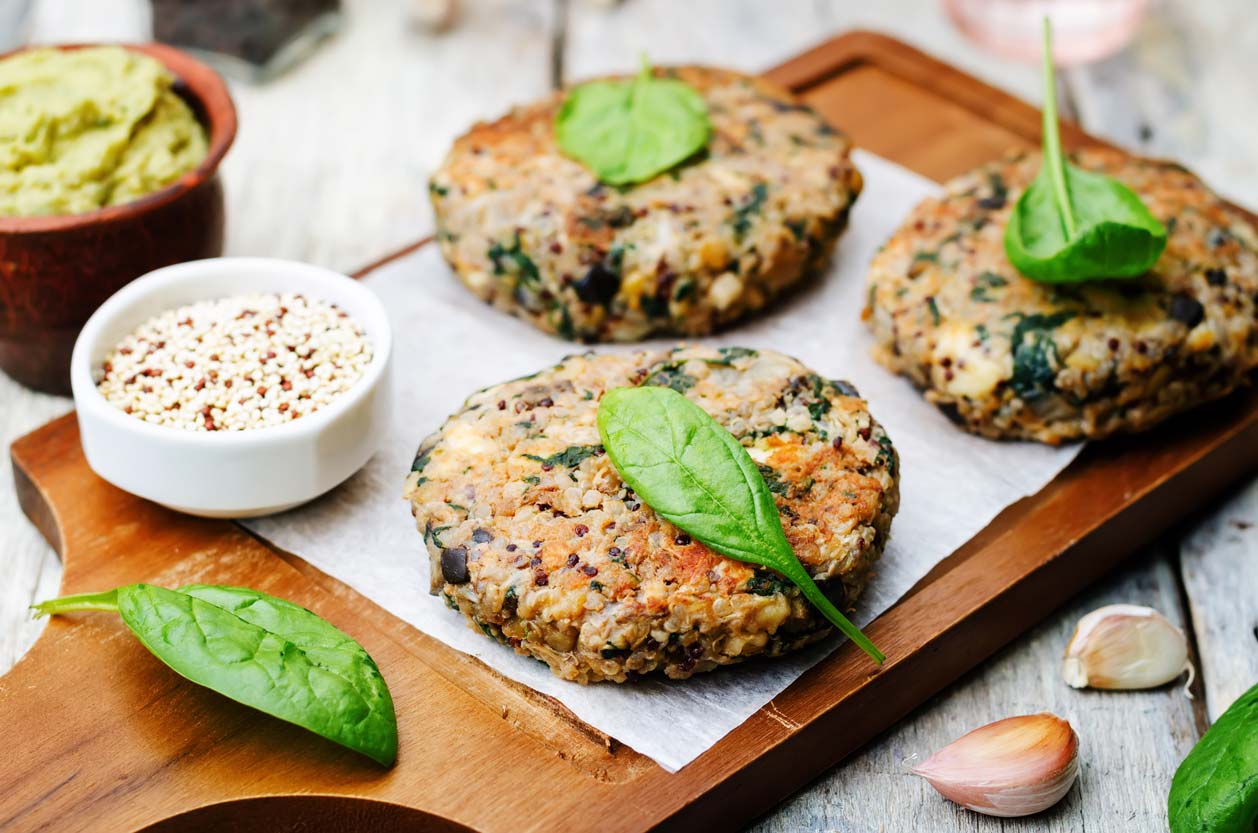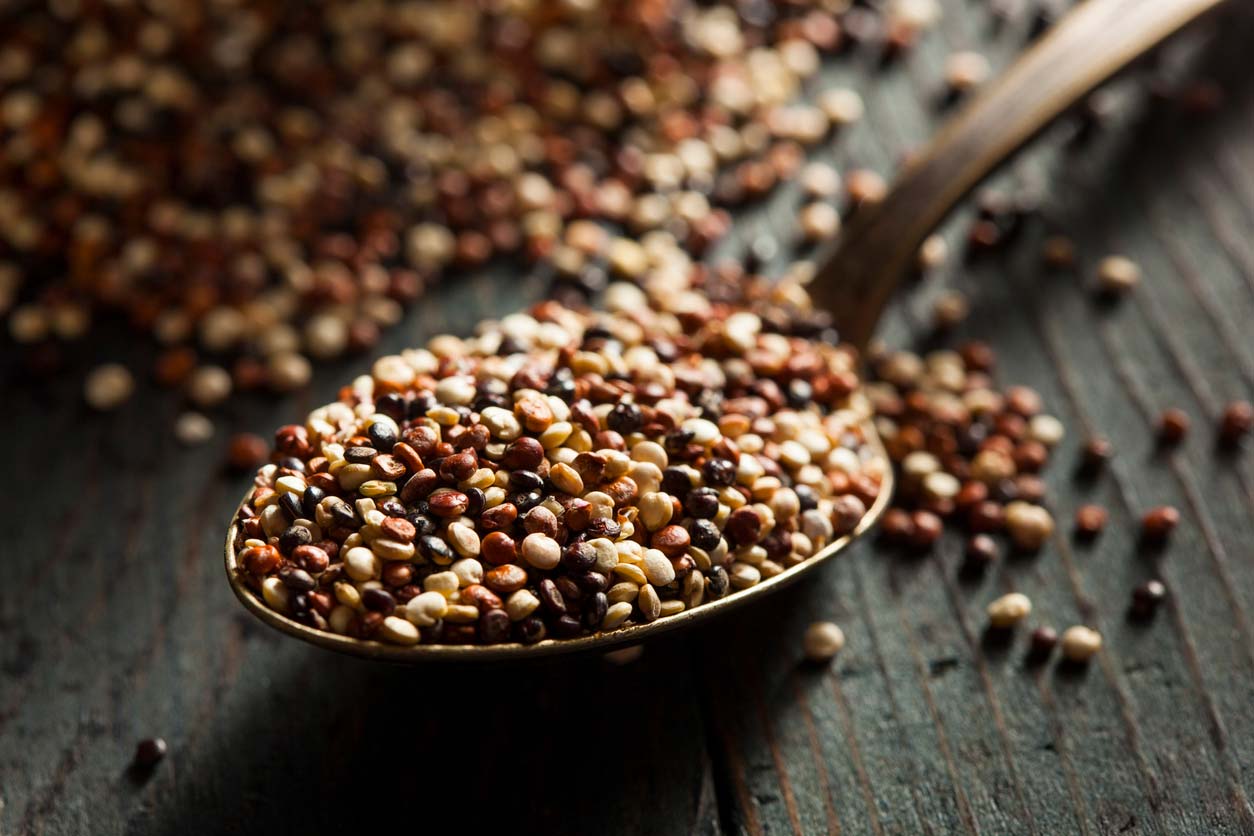Gone are the days when health food devotees were the only ones who’d heard of — and could pronounce — quinoa. From a peasant staple in South America’s remote highlands to the “it” grain of foodies, quinoa has taken the world by storm.
Quinoa — pronounced “keen-wah” — has enjoyed rapidly increasing popularity over the past couple of decades, and for good reason. It’s a gluten-free, high in protein, and filling grain. It works well in breakfast bowls and porridges as well as quinoa salads, homemade veggie burgers, and casseroles — in addition to being a flavorful side grain. The crop grows in over 50 countries around the world, is highly nutritious, and boasts a number of health benefits that make it a valuable pantry staple. But what exactly is quinoa, and is all the hype justified?
Quinoa as we know it was first cultivated high in the Andes Mountains in Peru and Bolivia and constituted a major part of the traditional Incan diet. This region is still the largest producer of quinoa, responsible for over 80% of the global supply. And while quinoa was once considered peasant food, it became more popular in the 1970s in health food circles in North America and Europe. Today, farmers are producing quinoa in the Rocky Mountains of the United States, as well as many other regions of the world.
There are three main types of quinoa, which can be identified by their colors: traditional (white), red, and black quinoa. You might also see tri-color varieties where the three colors are mixed.
Is Quinoa a Grain or a Seed?
So what is quinoa, really? Quinoa is a small, lightly-colored, spherically-shaped “grain.” But I put “grain” in quotes because quinoa isn’t technically a cereal grain at all. Quinoa falls into the category of pseudocereals (like amaranth, buckwheat, and chia), which are basically seeds that are prepared and eaten like grains.
The quinoa seeds are the main edible part of the quinoa plant, though its leaves are also edible. Since quinoa is gluten-free and higher in protein, it’s often touted as a healthy alternative to rice, especially since, unlike rice, it contains, at most, negligible amounts of arsenic.
When I tried to figure out the difference between a seed and a grain, though, I got a headache. Merriam-Webster defines seed as “the grain… of a plant used for sowing.” When I looked up “grain,” I got “the seed… of a cereal grass.” So seeds are grains, and grains are seeds. I’m just going to have to let that debate rage on since, ultimately, quinoa is both.
Quinoa Nutrition
Quinoa is a nutrient-dense food. In just one cup (185 grams) of cooked quinoa, you’ll find a little over 200 calories and a number of vitamins and minerals. Quinoa is also a particularly good source of manganese, magnesium, folate, phosphorus, and copper. And it also offers some iron, zinc, and B vitamins.
That same serving of cooked quinoa also contains eight grams of protein, including all nine of the essential amino acids that your body can’t make on its own.
6 Quinoa Health Benefits

Don’t let the tiny size of the quinoa seed fool you, though. Not only is quinoa packed with nutrients and is a tasty addition to a number of dishes, studies on quinoa, and its unique compounds, have found some impressive health benefits.
1. Quinoa may have anticancer properties.
Quinoa is rich in antioxidants and phytochemicals that may help protect cells against oxidative diseases like cancer. One 2018 study found that 17 potential bioactive peptides derived from quinoa had powerful antioxidant properties, showing the ability to inhibit colon cancer cell growth in a lab setting. An even more recent 2020 report in the journal Critical Reviews of Food Science and Nutrition came to similar conclusions. The authors stated that gluten-free pseudocereals (like quinoa) have peptides that have promising anticancer, antioxidant, and anti-inflammatory properties relevant to human health.
2. Quinoa may protect against heart disease and metabolic syndrome.
Enjoying quinoa may help keep some heart health biomarkers, like blood fats, in an optimal range. A 2017 dose-response randomized, controlled, single-blind trial compared the impacts of 25 and 50 grams of quinoa consumed per day for 12 weeks, among 50 overweight or obese individuals. The researchers found that the group who consumed 50 grams of quinoa daily experienced an average reduction in triglycerides of 1.14 to 0.72 mmol/L, as well as a 70% reduction in the prevalence of metabolic syndrome.
3. Quinoa advantages may include regulating blood sugar.
In a 2017 study, 30 prediabetic participants were randomized into two groups, to either receive processed quinoa or a placebo (maltodextrin) for 28 days, before and after which BMI, HbA1C (a measure of long-term blood sugar levels), satiety, and fullness were assessed. The quinoa group experienced a significant reduction in BMI and HbA1C values and an increase in reported feelings of satiety. The placebo group had no significant differences.
4. Quinoa grains may support healthy weight loss and maintenance.
Quinoa could be an excellent staple food to include in your diet if you’re looking to achieve a healthy weight. In a 2015 review, researchers concluded that quinoa consumption is able to effectively increase satiety and feelings of fullness, reduce fat tissue, and even lower inflammation related to obesity. Quinoa is a high-fiber food, which may help prevent overeating and excessive calorie intake, promoting healthy weight loss.
5. Quinoa may have immune-boosting properties.
According to a 2017 study, quinoa contains bioactive polysaccharides — a type of carbohydrate — that have promising potential as a natural antioxidant and immune regulator. The authors of this study, and researchers from another study more recently published, suggest that bioactive polysaccharides extracted specifically from quinoa could have food or drug applications.
6. Eating quinoa may improve liver function.
Quinoa may also have particular protective effects against diseases of the liver. A 2019 study among some very unfortunate rats found that quinoa seed powder had cytotoxicity against liver cancer cells and may be protective against non-alcoholic fatty liver disease, a condition that can become a risk factor for liver cancer. Another study similarly found that quinoa intake prevented fatty liver in obese mice.
All of this adds up to the potential for expanding life expectancy. A 2015 study by Harvard Public School of Health found that eating a daily bowl of quinoa (or other whole grains) reduces the risk of premature death from diseases like cancer, heart disease, respiratory disease, and type 2 diabetes by 17%.
Potential Downsides of Eating Quinoa

There are a few issues to watch out for with quinoa.
Quinoa is high in fiber, which is an important nutrient but can cause digestive disturbances if you’re not used to eating a fiber-rich diet. If this is the case, it’s best to introduce it into your diet slowly or in smaller portions.
Also, because its seeds are so small, they aren’t easily sifted, so little bits of debris can sneak in from time to time. This seems to vary from batch to batch. But if you find that your quinoa is pebble-prone, it could be wise to examine your quinoa for any unwanted particles, like small pebbles, that might have found their way into the harvest. You can do this by spreading raw quinoa out on a large baking sheet and sifting through it, or placing it in a very fine mesh strainer and running water through as you search for anything that needs to be discarded. As a few people have discovered the hard way (literally!), if it chips your tooth, it wasn’t quinoa.
Saponins
After you’ve examined your quinoa seeds, you need to rinse them. This is because they have a bitter coating of saponin, which should be removed before consumption to give them a milder flavor. Saponins are actually nature’s way of keeping birds and insects away from quinoa crops. And eating them can also be a mild stomach irritant for some people.
To rid your quinoa of saponins, you can soak it for at least five minutes (or overnight if you want to start the germination process), and then rinse it. Manufacturers sometimes rid quinoa of saponins during processing using a dry method that “polishes” the seeds through an abrasion process. This is often why you’ll see packaged “pre-washed” quinoa at the grocery store. But polished quinoa has lost some important nutrients, including half the fiber, as well as some of the protein, vitamins, and minerals.
However, if you don’t remove the saponins from your quinoa before cooking it, it’s probably not a big deal for most people. Some researchers actually say that saponins are phytochemicals, which might offer some health benefits. Still, some people are more sensitive to saponins than others and can have an almost allergy-like reaction, with side effects like diarrhea, bloating, and abdominal discomfort. If you find yourself feeling any strange side effects after eating home-cooked quinoa, try washing your seeds thoroughly before cooking next time to see if the saponins are the culprit.
Is Quinoa Ethical and Sustainable?
Quinoa is an Andean plant that originated in Peru and Bolivia. As it has become increasingly popular as an export crop, the high demand has driven up the price. In fact, the cost of quinoa increased by 600% between 2000-2008 and has continued to go up since then. Because it’s now more profitable to sell quinoa to wealthy Americans and Europeans than Peruvian subsistence farmers, this traditional staple crop has become economically inaccessible to many indigenous people. In other words, while people in Europe and North America are eating more and more quinoa, some people living in quinoa farming communities can no longer afford it.
In some cases, farmers sell most of their valuable quinoa for cash and feed their families and communities cheaper and less nutritious grains, such as white rice and pasta. While quinoa production in Bolivia has skyrocketed in the past decade, domestic consumption has actually fallen.
Since export-quality quinoa is so much more profitable than other traditional crops, many farmers have traded their longstanding practices of mixed agriculture for quinoa monocropping. While this causes their profits to rise in the short-term, the longer-term effects of monocropping include degradation of soil, inefficient land use, and loss of biodiversity. Chasing profits today may, over time, destroy the fertility of the land base that produces those profits.
Of course, higher quinoa prices have also led to more income for farmers, so it isn’t all bad news in Bolivia and Peru. And now that quinoa is being cultivated in other countries, the stress on Andean farmers to provide all of the world’s quinoa is beginning to ease.
Should You Buy Fair-Trade or Organic Quinoa?
To minimize your contribution to ethical and sustainability concerns in the quinoa industry, it’s best to buy fair-trade varieties. Fair-trade organizations pay farmers a living wage, in addition to premiums that the farmers reinvest in their communities. In this way, the net impact of your consumption on the surrounding communities can be positive.
What about the eternal question, organic or not? Interestingly, the natural saponins found in quinoa render them unpalatable to most pests, so farmers can go easy on pesticides and other chemicals. For this reason, buying quinoa organically offers less of a relative benefit than a lot of other foods. If your food budget forces you to choose a limited number of organic items, then quinoa might not be the top place to focus.
Source: Food Revolution Network, adapted
